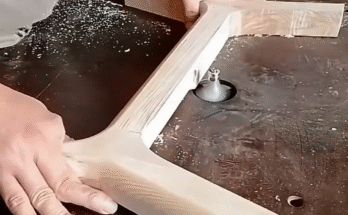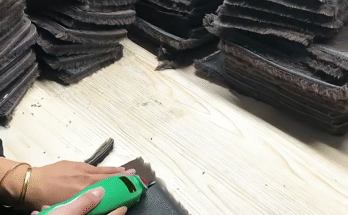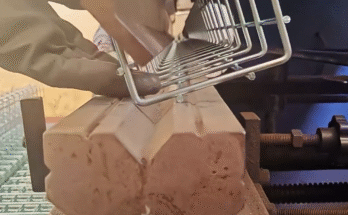Waterjet cutting, sometimes referred to as “water knife” cutting, is a highly precise and efficient method for cutting various materials, including challenging thickened tiles. This process utilizes a high-pressure stream of water, often mixed with an abrasive, to create clean and intricate cuts.
Understanding the “Thickened Tile” Challenge: Thickened tiles, due to their increased density and hardness, pose a greater challenge for traditional cutting methods, often leading to chipping, cracking, or slow progress. Waterjet cutting overcomes these issues by providing a non-contact, high-energy cutting solution.
The Step-by-Step Aqua-Precision Process:
Phase 1: Preparation & Design (The Digital Blueprint)
- Design Creation & Optimization:
- Software Design: The desired cut pattern (shapes, curves, holes, etc.) is created using CAD (Computer-Aided Design) software (e.g., AutoCAD, SolidWorks, Rhino). This digital file will guide the waterjet machine.
- Nesting (for multiple cuts): If cutting multiple identical or different pieces from a single tile, “nesting” software is used to optimize the layout, minimizing material waste.
- Kerf Compensation: The software accounts for the “kerf” (the width of the cut made by the waterjet stream), ensuring accurate dimensions of the final piece.
- Material Selection & Inspection:
- Tile Quality Check: Inspect the thickened tiles for any pre-existing cracks, chips, or imperfections that could affect the cutting process or final product.
- Material Data Input: Input the specific material properties of the thickened tile (e.g., type of ceramic, porcelain, stone, thickness) into the waterjet machine’s software. This helps the machine determine optimal cutting parameters.
- Machine Setup & Calibration:
- Nozzle Selection: Choose the appropriate cutting nozzle based on the tile’s thickness and desired cut quality. Smaller nozzles offer finer cuts, while larger ones allow for faster cutting of thicker materials.
- Abrasive Loading (if applicable): For most thickened tiles, an abrasive (typically garnet) is mixed with the water. Load the abrasive hopper with the correct grit size.
- Water Supply & Pressure Check: Ensure a clean and consistent water supply to the intensifier pump. Verify that the system can achieve the required water pressure (often 30,000 to 90,000 PSI or more).
- Cutting Table Preparation: Clean and level the cutting table, ensuring proper support for the thickened tile. Some tables have sacrificial slats to protect the main surface.
Phase 2: The Cutting Action (The Aqua-Precision Stroke)
- Tile Placement & Securing:
- Accurate Positioning: Carefully place the thickened tile onto the cutting table, aligning it with the machine’s reference points.
- Securing (if necessary): For some complex cuts or very large tiles, it might be necessary to secure the tile with clamps or weights to prevent movement during cutting. However, waterjet cutting exerts minimal side force, so heavy clamping is often not required.
- Parameter Setting & Verification:
- Pressure & Flow Rate: Set the optimal water pressure and flow rate based on the tile’s material, thickness, and desired cut speed/quality. Higher pressure and flow generally lead to faster cuts but consume more energy and abrasive.
- Feed Rate (Cutting Speed): Adjust the cutting head’s traverse speed. Slower speeds result in a smoother, more precise cut, while faster speeds are used for less critical cuts or to increase throughput.
- Abrasive Flow Rate: If using abrasive, fine-tune the abrasive flow rate to ensure efficient cutting without excessive waste.
- Pre-Cut Test (Optional but Recommended):
- For critical projects or new materials, perform a small test cut on a scrap piece of the same thickened tile. This allows for fine-tuning of parameters before committing to the main piece.
- Initiating the Cut:
- Safety First: Ensure all safety protocols are observed. Operators should wear appropriate personal protective equipment (PPE).
- Start Program: Initiate the cutting program from the control computer. The waterjet pump will ramp up to pressure, and the cutting head will begin its programmed path.
- Piercing: The waterjet will typically “pierce” the material at the start of each cut. This involves a controlled, slower entry to prevent cracking or delamination, especially in brittle materials like thickened tile.
- Monitoring the Cutting Process:
- Visual Inspection: Continuously monitor the cutting process for any anomalies, such as changes in cut quality, nozzle issues, or material shifting.
- Machine Feedback: Observe the machine’s display for pressure readings, flow rates, and any error messages.
Phase 3: Post-Cut Finishing (The Polished Result)
- Part Removal:
- Draining: Allow the water on the cutting table to drain completely.
- Careful Removal: Carefully remove the cut tile piece(s) from the cutting table. Be mindful of any sharp edges or remaining waste material.
- Cleaning & Inspection:
- Rinsing: Rinse the cut tile to remove any abrasive residue or debris.
- Quality Check: Thoroughly inspect the cut edges for smoothness, accuracy, and any signs of chipping, cracking, or delamination. Compare the finished piece to the original design specifications.
- Secondary Operations (if required):
- Edge Finishing: While waterjet cuts are generally clean, some applications may require additional edge finishing like polishing or grinding, especially for visible edges or aesthetic purposes.
- Deburring: Remove any minor burrs that might be present, although waterjet cutting typically produces very little burr.
Key Advantages of Waterjet Cutting for Thickened Tiles:
- No Heat Affected Zone (HAZ): Waterjet cutting is a cold cutting process, meaning it doesn’t generate heat that can alter the material’s properties or cause discoloration, unlike laser or plasma cutting. This is crucial for heat-sensitive tiles.
- Minimal Material Stress: The cutting force is applied directly and precisely, minimizing stress on the tile and reducing the risk of cracking or chipping, especially important for brittle thickened tiles.
- High Precision & Intricate Cuts: Waterjets can create highly accurate and complex shapes, including tight corners, small holes, and detailed patterns that would be difficult or impossible with other methods.
- Versatility: Capable of cutting a wide range of thickened tile materials, including ceramics, porcelain, natural stone (granite, marble, quartz), and even some composites.
- Reduced Dust & Fumes: The process is relatively clean, producing no airborne dust or hazardous fumes, making it safer for operators and the environment.
- Less Material Waste: With precise cutting and nesting capabilities, waterjet cutting helps optimize material usage.



